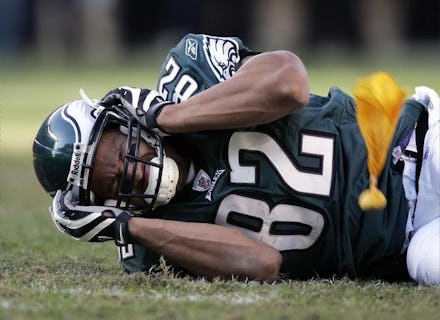Scientists Nearing Huge Breakthrough to Treat NFL Concussions

The NFL has been in hot water for the past few years after scientists linked cognitive and behavioral changes to severe or multiple concussions. More than 4,500 former NFL players are suffering from neurological disorders, like dementia and Alzheimer's, as a result of their time on the field. A $765 million settlement over concussion-related injuries is looming.
Concussions are a common cause of neurological disorders and occur when the head is hit so hard that a person experiences a change in mental capabilities, confusion, disorientation, or memory loss. The Brain Injury Research Center reports that such injuries can manifest later in life as cognitive impairments, like dementia, parkinsonism, Alzheimer's, and of loss of coordination. Though the NFL has responded with some rule changes to protect the players, many claim their efforts are not working.
However, exciting discoveries unfolding in concussion research may prevent players from having to throw in the towel on maintaining a healthy brain for the sake of the game. The NFL and science researchers make strange bedfellows, but independent groups conducted this study which shows promise for preventative treatment.
Scientists have only recently begun to understand the molecular side of concussions. The brain is notoriously difficult to study in relation to concussions because it is so well protected. Not only does the skull act as a barrier, but several layers of membrane also surround the organ to keep out unwanted molecules.
While this is good news for your brain, it's bad news for research.
When scientists remove the skull of a concussed animal to take a peek at the brain, they disturb the protective membranes. As you can imagine, ripping off a skull causes a separate physiological response from the brain's reaction to a concussion.
Luckily, nerds never stop.
Scientists have found a way around this problem by using power tools and a little imagination. They thinned down the skull of mice to the thickness of a human hair, which allowed a microscope to see through it and into the brain. They then tapped this soft skull, causing it to hit the brain and recapitulate a concussion.
Then the magic really began.
Scientists were able to capture images in real-time of what happens to the brain immediately after it incurs injury, which hadn't been done before. The protective membranes that surround the brain were torn during the impact and allowed unwanted molecules to leak in, the most important of which are free radicals. These molecules play a role in the inflammatory response healthy tissues have after injury. However, in excess, they cause cell death and tissue damage.
The brain did send an injury response that healed the torn protective membranes and restored normal function. However, it didn't do this until free radicals did damaged the brain tissue. In fact, free radicals migrated within the brain and caused damage in areas far away from the concussion site.
This new information was an opportunity to try a treatment. Since free radicals seemed to contribute to brain damage, the team targeted them for destruction with antioxidants. In a subsequent experiment, researchers applied a thin layer of antioxidants to the mice's thinned skull after a concussion in hopes that the tissue damage would be less severe.
There was 70% less tissue damage in the mice treated with antioxidants immediately, and a 50% reduction in those treated three hours after the concussion.
The fact that antioxidants can save brain tissue in mice within a window of time is exciting news. This research has not yet been tested in humans, but it shows promise that clinical intervention can protect brain tissue after an injury.
Maybe in the near future, football players will be given an antioxidant patch to combat potential brain damage after a hard hit.
It's not any more far-fetched than high profile players following the medical advice in The Return To Play guidelines after a concussion, right?